The casks used in real ale are historic in nature. They come in various sizes and each size has a name.
From the Wikipedia
From the largest size down to the smallest.
Tun
The tun is a barrel that is double the size of a butt and has a capacity of 216 imperial gallons (982.0 l).
Butt
The butt of beer was equal to half a tun, two hogsheads or 108 imperial gallons (491.0 l).
Hogshead
The hogshead of beer and ale was equal to a quarter of a tun, half a butt, a barrel and a half or three kilderkins. This unit is close in size to the wine hogshead.
Hogshead
From the mid 15th century until 1824 the ale hogshead was defined as 48 ale or beer gallons (221.8 l). In 1688 the ale hogshead was redefined to be 51 ale or beer gallons (235.7 l). In 1803 ale hogshead was again redefined to be 54 ale or beer gallons (249.5 l), equivalent to the beer hogshead.
Beer hogshead
From the mid 15th century until 1824 the beer hogshead was defined as 54 ale or beer gallons.
Imperial ale or beer hogshead
In United Kingdom and its colonies, with the 1824 adoption of the imperial system, the ale or beer hogshead was redefined to be 54 imperial gallons. The ale or beer hogshead is therefore exactly 245.48886 litres or approximately 8.669 cubic feet.
Barrel
The barrel of beer or ale was equal to two kilderkins or 2⁄3 of a beer or ale hogshead. This is somewhat larger than the wine barrel.
Barrel
As with the hogshead, the ale barrel underwent various redefintions. Initially 32 ale or beer gallons (147.9 l), it was redefined in 1688 as 34 ale or beer gallons (157.1 l) and again in 1803 as 36 ale or beer gallons (166.4 l).
Beer barrel
The beer barrel was defined as 36 ale or beer gallons until the adoption of the imperial system.
Imperial beer or ale barrel
The adoption of the imperial system saw the beer or ale barrel redefined to be 36 imperial gallons, which is exactly
9,987.09958 cubic inches or approximately 163.659 litres[nb 2].
Kilderkin
The kilderkin (from the Dutch for “small cask”) is equal to half a barrel or two firkins.[2]
Kilderkin
The ale kilderkin likewise underwent various redefintions. Initially 16 ale or beer gallons (73.94 l), it was redefined in 1688 as 17 ale or beer gallons (78.56 l) and again in 1803 as 18 ale or beer gallons (83.18 l)
Beer kilderkin
Until the adoption of the imperial system the beer kilderkin was defined as 18 ale or beer gallons.
Imperial kilderkin
With the adoption of the imperial system the kilderkin was redefined to be 18 imperial gallons, which is exactly 81.82962 litres[nb 2] or approximately 2.890 cubic feet.
Ale Firkin
The ale or beer firkin (from Middle Dutch vierdekijn meaning “fourth”) is a quarter of an ale or beer barrel or half a kilderkin. This unit is much smaller than the wine firkin. Casks in this size (themselves called firkins) are the most common container for cask ale.
Firkin
From the mid 15th century until 1688 the ale firkin was defined as 8 ale or beer gallons (36.97 l). In 1688 the ale firkin was redefined to be 8 1⁄2 ale or beer gallons (39.28 l). In 1803 ale firkin was again redefined to be 9 ale or beer gallons (41.59 l), equivalent to the beer firkin.
Beer firkin
From the mid 15th century until 1824 the beer firkin was defined as 9 ale or beer gallons.
Imperial beer or ale firkin
The beer or ale firkin was redefined to be 9 imperial gallons in 1824. It is therefore exactly 40.91481 litres[nb 2] or approximately 1.445 cubic feet.
Pin
A pin is equal to half a firkin (4.5 imp gal or 20 l). Plastic versions of these casks are known as “polypins” and are popular in homebrewing. The word “polypin” has subsequently become commonly used in Britain for bag-in-box containers of any size.
Gallon
Originally the 282-cubic-inch ale or beer gallon was used. With the adoption of the imperial system in the United Kingdom and its colonies the system was redefined in terms of the imperial gallon.
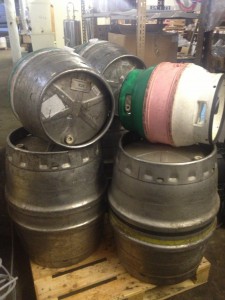
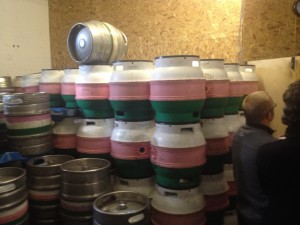
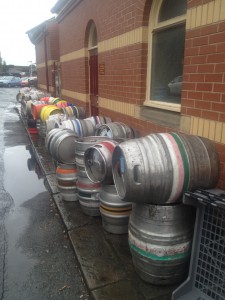
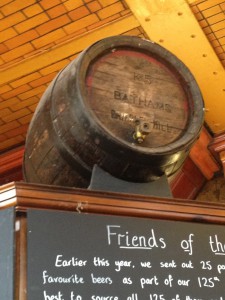
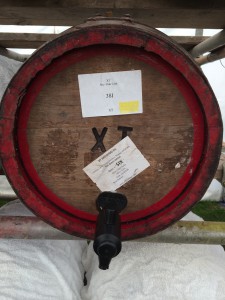
You must be logged in to post a comment.